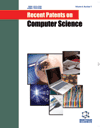- Home
- A-Z Publications
- Recent Patents on Computer Science
- Previous Issues
- Volume 12, Issue 4, 2019
Recent Patents on Computer Science - Volume 12, Issue 4, 2019
Volume 12, Issue 4, 2019
-
-
ACO Inspired Computer-aided Detection/Diagnosis (CADe/CADx) Model for Medical Data Classification
More LessAuthors: Anuradha Dhull, Kavita Khanna, Akansha Singh and Gaurav GuptaBackground: Computer-Assisted Diagnosis (CAD) has become a common practice of use in the healthcare industry due to its improved accuracy and reliability. The CAD systems are expected to improve the quality of medical care by assisting healthcare professionals with a wide range of clinical decisions. A CAD system is a combination of Computer-Assisted Detection (CADe) and Computer-Assisted Diagnosis (CADx) syste Read More
-
-
-
Grey Relational Analysis based Keypoints Selection in Bag-of-Features for Histopathological Image Classification
More LessAuthors: Raju Pal and Mukesh SaraswatBackground: With the expeditious development of current medical imaging technology, the availability of histopathological images has been increased in a large number. Hence, histopathological image classification and annotation have emerged as the prime research fields in the pathological diagnosis and clinical practices. Several methods are available for the automation of image classification. Methods: Recentl Read More
-
-
-
Efficient Bag-of-Features using Improved Whale Optimization Algorithm for Histopathological Image Classification
More LessAuthors: Varun Tiwari and Sushil C. JainBackground: The whale optimization algorithm is one of the popular meta-heuristic algorithms which has successfully been applied in various application areas such as image analysis and data clustering. However, the slow convergence rate and chances of sticking into the local optima due to improper balance of its exploration and exploitation phases are some of its pitfalls. Therefore, in this paper, a new improved whale op Read More
-
-
-
SOOP: A Swarm-Optimized Opinion Prediction Model for S-Health Governance
More LessAuthors: Akshi Kumar and Abhilasha SharmaBackground: To realize a viable and resilient smart city-smart nation scenario, “peoplecentric” strategic technology components are imperative to eventually create smart outcomes for citizens. Smart health is one such domain where the government is putting incessant effort to ensure social well-being and sustainability. Contemplation of public opinion plays a very significant role in the process of government policy evaluation. Read More
-
-
-
Optimized Model for Cervical Cancer Detection Using Binary Cuckoo Search
More LessAuthors: Rachna Jain, Saurabh R. Sangwan, Shivam Bachhety, Surbhi Garg and Yash UpadhyayBackground: Cervical Cancer is one of the leading causes of deaths among women in India. Accurate and early detection of cancer seems to be a fruitful approach in the diagnosis process. It will be a boon for the medical industry. Prediction of cervical cancer using all the features takes a lot of time and computational resources. Hence, reducing the features and taking only essential features into consideration is an effective sol Read More
-
-
-
A Genetic Algorithm Based Feature Selection for Handwritten Digit Recognition
More LessAuthors: Savita Ahlawat and Rahul RishiBackground: The data proliferation has been resulted in large-scale, high dimensional data and brings new challenges for feature selection in handwriting recognition problems. The practical challenges like the large variability and ambiguities present in the individual’s handwriting style demand an optimal feature selection algorithm that would be capable to enhance the recognition accuracy of handwriting recognition s Read More
-
-
-
Importance of Feature Selection and Data Visualization Towards Prediction of Breast Cancer
More LessBackground: Breast cancer is one of the most common forms of cancers among women and the leading cause of death among them. Countries like United States, England and Canada have reported a high number of breast cancer patients every year and this number is continuously increasing due to detection at later stages. Hence, it is very important to create awareness among women and develop such algorithms Read More
-
-
-
Feature Selection for Histopathological Image Classification using levy Flight Salp Swarm Optimizer
More LessAuthors: Venubabu Rachapudi and Golagani L. DeviBackground: An efficient feature selection method for Histopathological image classification plays an important role to eliminate irrelevant and redundant features. Therefore, this paper proposes a new levy flight salp swarm optimizer based feature selection method. Methods: The proposed levy flight salp swarm optimizer based feature selection method uses the levy flight steps for each follower salp to deviate them from lo Read More
-
-
-
Role of Technology in Solid Waste Management: A Review
More LessAuthors: Jyoti Kumari, Gulshan Shrivastava, Akash Sinha and Prabhat KumarBackground: Waste management is an essential process for the progress of any nation. The exponential growth in the urbanization and industrialization has brought the waste management issue into prime focus. The practices adopted for waste management vary across the nations as well as regions and sectors. Solid waste management encompasses a number of activities ranging from waste collection to waste rec Read More
-
-
-
Performance Analysis of QMF Filter Bank For Wireless Voip in Pervasive Environment
More LessAuthors: Ravindra Luhach, Chandra K. Jha and Ashish K. LuhachBackground: Voice over Internet Protocol (VoIP) has emerged as one of the most significant technology in the field of communication and evolved as a substitute to the conventional communication method as the Public Switched Telephone Network (PSTN). Along with the advantages such as scalability and security, VoIP has some threats such as voice quality and interference that must be dealt with. The voice quality in VoIP is Read More
-
-
-
Speed of Things (SoT): Evolution of Isolation-to-Intermingle (I2I) Technology Transition Towards IoT
More LessAuthors: Ravishanker, Ashish K. Luhach, Sykam V.N. Kumar and Ramesh C. PooniaBackground: In today’s world it is highly difficult to manage the smart things and fulfill the communication needs without the Internet as it provides ultimate means for human to human (H2H) communication. The ‘things’ could be entities or devices that contribute for the communication. But to enhance and improve such smart communication among the things that involves nonhuman intervention, there is a need to add few mo Read More
-
Most Read This Month
Article
content/journals/cseng
Journal
10
5
false
en


